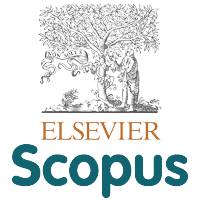Effect of Castanopsis megacarpa Extract on Mortality, Longevity Development and Feeding of Crocidolomia pavonana Larvae
Abstract
Keywords
Full Text:
PDFReferences
Amoabeng, B. W., Johnson, A. C., & Gurr, G. M. (2019). Natural enemy enhancement and botanical insecticide source: a review of dual use companion plants. Applied Entomology and Zoology, 54(1), 1–19. crossref
Arivoli, S., & Tennyson, S. (2013). Antifeedant activity, development indices and morphogenetic variation of plant extracts against Spodoptera litura (Fab.) (Lepidoptera : Noctuidae). Journal of Entomology and Zoology Studies, 1(4), 87–96. Retrieved from pdf
Arnason, J. T., Sims, S. R., & Scott, I. M. (2012). Natural products from plants as insecticides. In Encyclopedia of Life Support Systems (EOLSS) (pp. 1–8). Retrieved from pdf
Biondi, A., Desneux, N., Siscaro, G., & Zappalà, L. (2012). Using organic-certified rather than synthetic pesticides may not be safer for biological control agents: Selectivity and side effects of 14 pesticides on the predator Orius laevigatus. Chemosphere, 87(7), 803–812. crossref
Dubey, N. K., Shukla, R., Kumar, A., Singh, P., & Prakash, B. (2010). Prospects of botanical pesticides in sustainable agriculture. Current Science, 98(4), 479–480. Retrieved from pdf
Khater, H. F. (2012). Prospects of botanical biopesticides in insect pest management. Pharmacologia, 3(12), 641–656. crossref
Koul, O. (2008). Phytochemicals and insect control: An antifeedant approach. Critical Reviews in Plant Sciences, 27(1), 1–24. crossref
Lina, E. C., Syahbirin, G., & Dadang, D. (2017). Mixed extracts formulation of Tephrosia vogelii and Piper aduncum. In 2017 The Asia-Pacific Conference on Life Sciences and Biological Engineering (p. APLSBE-812). Nagoya, Japan. Retrieved from website
Martinou, A. F., Seraphides, N., & Stavrinides, M. C. (2014). Lethal and behavioral effects of pesticides on the insect predator Macrolophus pygmaeus. Chemosphere, 96, 167–173. crossref
Miresmailli, S., & Isman, M. B. (2014). Botanical insecticides inspired by plant-herbivore chemical interactions. Trends in Plant Science, 19(1), 29–35. crossref
Nawrot, J., & Harmatha, J. (2012). Phytochemical feeding deterrents for stored product insect pests. Phytochemistry Reviews, 11(4), 543–566. crossref
Nurtjahja, K., Kelana, T. B., Suryanto, D., Priyani, N., Rio, G., Putra, D. P., & Arbain, D. (2013). Antimicrobial activity of endemic herbs from Tangkahan Conservation Forest North Sumatera to bacteria and yeast. HAYATI Journal of Biosciences, 20(4), 177–181. crossref
Paul, D., & Sohkhlet, M. D. (2012). Anti-feedant, repellent and growth regulatory effects of four plant extracts on Pieris brassicae larvae (Lepidoptera: Pieridae). Open Access Scientific Reports, 1(10), 485. Retrieved from pdf
Pretty, J., Benton, T. G., Bharucha, Z. P., Dicks, L. V., Flora, C. B., Godfray, H. C. J., … Wratten, S. (2018). Global assessment of agricultural system redesign for sustainable intensification. Nature Sustainability, 1, 441–446. crossref
SAS Institute. (2008). Introduction to statistical modeling with SAS/STAT software (Book Excerpt). SAS/STAT 9.3 User’s Guide. Cary, NC: SAS Institute Inc. Retrieved from pdf
Sitepu, N., & Bahar, R. (2019). Uji toksisitas ekstrak etanol kulit batang cepcepan (Castanopsis costata BL) dengan metode Brine Shrimp Lethality Test (BSLT). Borneo Journal of Pharmascientech, 3(1), 20-27. Retrieved from website
Syahputra, E. (2013). Insecticidal activities of Barringtonia sarcostachys bark extract against cabbage head caterpillar Crocidolomia pavonana (F.). Journal of the International Society for Southeast Asian Agricultural Sciences, 19(2), 8–17. Retrieved from pdf
Syahputra, E., Prijono, D., Dadang, Manuwoto, S., & Darusman, L. K. (2006). Respons fisiologi Crocidolomia pavonana terhadap fraksi aktif Calophyllum soulattri. HAYATI Journal of Biosciences, 13(1), 7–12. crossref
Szczepanik, M., Grudniewska, A., Zawitowska, B., & Wawrzeńczyk, C. (2014). Structure-related antifeedant activity of halolactones with a p-menthane system against the lesser mealworm, Alphitobius diaperinus Panzer. Pest Management Science, 70(6), 953–958. crossref
van Loon, J. J. A., Wang, C. Z., Nielsen, J. K., Gols, R., & Qiu, Y. T. (2002). Flavonoids from cabbage are feeding stimulants for diamondback moth larvae additional to glucosinolates: Chemoreception and behaviour. Entomologia Experimentalis et Applicata, 104(1), 27–34. crossref
Zapata, N., Budia, F., Viñuela, E., & Medina, P. (2009). Antifeedant and growth inhibitory effects of extracts and drimanes of Drimys winteri stem bark against Spodoptera littoralis (Lep., Noctuidae). Industrial Crops and Products, 30(1), 119–125. crossref
DOI: http://doi.org/10.17503/agrivita.v41i3.2331
Copyright (c) 2019 UNIVERSITAS BRAWIJAYA

This work is licensed under a Creative Commons Attribution-NonCommercial 4.0 International License.








